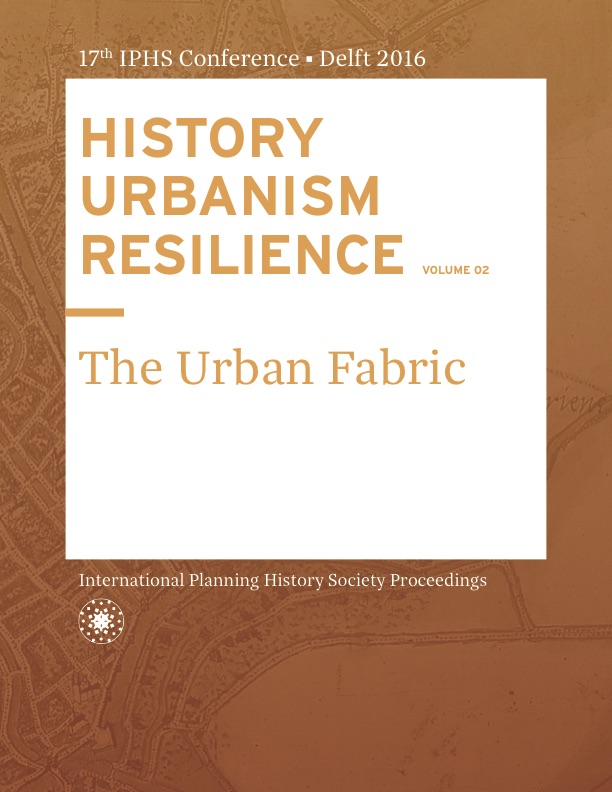Ebenezer Howard Idea in the planning of Krakow. A short history
DOI:
https://doi.org/10.7480/iphs.2016.2.1239Abstract
Neither professional planner nor architect, Ebenezer Howard has remained an outstanding figure in the field of planning and, more generally, shaping the structure and image of contemporary cities. His Garden City notion has been used, or sometimes misused, in numerous projects, quotations, references and other forms of attention being paid.Howard’s 1898 publication became known to Polish readers, through reviews, as early as in 1899. In 1912 Howard paid a brief visit to Krakow. He delivered a lecture there and, after having gained some site orientation, issued comments on Krakow urban development. His calling Krakow ”a garden city from natural growth” was proudly quoted in there.
Since Howard had fully published his concept and visited the city, Krakow faced a number of challenges which added new stages to its thousand-year-long development history and resulted in new urban forms and heritage. In 1918 the city ceased to be powerful Austrian fortress it had been since 1850, while the 1909-1915 eight-fold enlargement resulted in substantial opportunities of development on vast “Great Krakow” areas. Its harmonious urban development during the Polish Second Republic (1918-1939) was broken by the World War II and Nazi occupation (1939-1945). The city’s rapid growth in the communist Poland (1945-1989) started in 1949 with the construction of Nowa Huta, a planned “Socialist” city next to Krakow and continued until 1988 with numerous Modernist housing projects and industrialization. Since in 1989-1990 market economy and self-government were restored in Poland, the city, despite unaltered area and population figures, has been turning into a metropolitan centre through intensification and thorough transformations.
It could be initially expected that, like most new theories, Howard’s ideas would sink into oblivion in Krakow. However, they have never been entirely forgotten. Some of the urban challenges were responded with the solutions influenced by the Garden City concept. Although the attempts to link the Salwator Hill housing project (1908) with Howard’s ideas have already been proved impossible, some of the Interwar Period projects, especially the Officers’ Neighbourhoods (planned in 1924-1932), based on the regulation plans, seem to have been inspired by the Garden City. Another case can be found in the first neighbourhoods of Nowa Huta, which had been designed in 1949 before the Socialist Realism doctrine fully took over until 1955. And recently Garden City seems to be a notion appreciated by potential customers and therefore used in advertisements on new housing projects, however that usually differs from what Howard actually meant.
The article deals with direct and indirect impact of Howard’s concept upon Krakow urban development in particular periods. According to the research the extent of Garden City concept’s influence was weakening with time. The range of effects and the number of examples of Garden-City-related approach was limited. Moreover, the popularity of Howard’s concept did not necessarily mean sharing his original views. Finally, it would be less justified to call Krakow “the garden city from natural growth” nowadays than over a hundred years ago.
References
Barucka, Edyta, W szkatulach zieleni. Europejski ruch miast ogrodow 1903-1930, Warszawa: Wydawnictwo Uniwersytetu Warszawskiego, 2014.
Beevers, Robert, The Garden City Utopia. A critical biography of Ebenezer Howard. London: Palgrave Macmillan, 1988.
Bogdanowski, Janusz, Warownie i zielen Twierdzy Krakow. Krakow: Wydawnictwo Literackie, 1979.
Brückman De Renstrom, Katarzyna, Salwator, Krakow, Europa [with English summary: Salwator – Cracow – Europe]. Krakow: Politechnika Krakowska, 2003.
Butelski Kazimierz, Architekt Zbigniew Kupiec 1905-1990. Ewolucja tworczosci od modernizmu do regionalizmu [with English summary: Architect Zbigniew Kupiec 1905-1990. Evolution from Modernism to regionalism]. Krakow: Fundacja Pro Architectura, 2012.
Czas, no. 281, Krakow, 1912.
Czas, no. 367, Krakow, 1912.
Czyzewski, Adam, Trzewia Lewiatana. Miasta ogrody i narodziny przedmiescia kulturalnego [title in English: Leviatan’s Entrails. Garden Cities and Birth of Cultural Suburb]. Warszawa: Panstwowe Muzeum Etnograficzne, 2009.
Dobrzynski, Wladyslaw, Istota i rozwoj idei Howarda. Miasto - ogrod. Warszawa: Przegląd Techniczny, 1917.
Hall, Peter; Ward, Colin, Sociable Cities. The 21st-Century Reinvention of the Garden City. Abingdon and New York: Routledge, 2014.
Hardy, Dennis, From Garden Cities to New Towns: Campaigning for Town and Country Planning, 1899-1946. New York: Routledge, Chapman & Hall, 1991.
Howard, Ebenezer, To-morrow: a Peaceful Path to Real Reform, London: Swan Sonnenschein & Co., 1898.
Howard, Ebenezer, Garden Cities of To-morrow. London: Swan Sonnenschein & Co., 1902.
Howard, Ebenezer, To-morrow: a Peaceful Path to Real Reform, with commentaries by Hall, Peter; Hardy, Dennis; Ward, Colin. Abingdon and New York: Routledge, 2003.
Juchnowicz, Stanislaw, Nowa Huta. Architektura, vol. 1. 1986.
Lorek, Andrzej, Kompozycja przestrzenna Nowej Huty w kontekscie teorii i praktyki urbanistycznej socrealizmu [in:] Narodziny Nowej Huty, ed. Jan Malecki. Krakow: Towarzystwo Milosnikow Historii i Zabytkow Krakowa, 1999.
Motak, Maciej, Nowa Huta. Introduction to its Town-Planning and Architectural History [in:] Future of the City – Mass Housing Estates or Multifamily Housing Complexes? Eco_Rehab3. Ed. Gyurkovich, Matuesz. Krakow 2012.
Motak, Maciej, Historia rozwoju urbanistycznego Krakowa w zarysie. Krakow: Wydawnictwo Politechniki Krakowskiej, 2012.
Nowa Huta. The New Town travel guides. Ed. Anapliotis, Sofia; Keeton, Rachel; Hulskes, Saskia. Almere: International New Town Institute, 2012.
Ostrowski, Waclaw, Sir Ebenezer Howard in Poland. Town & Country Planning, vol. 34, no. 11, 1966.
Studium uwarunkowan i kierunkow zagospodarowania przestrzennego Miasta Krakowa [Study of Conditions and Directions of Spatial Development of the City of Krakow]. Krakow. 2010, amended 2014.

